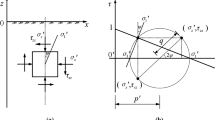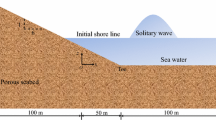Abstract
This study proposes a two-dimensional coupled approach to examine dynamic response of a sloping beach due to tsunami-like solitary wave. Wave motion is governed by Reynolds-averaged Navier–Stokes (RANS) equations, while the beach response is described with the poro-elastoplastic theory. The wave module and beach module are strongly integrated, resulting in a profound investigation of the solitary wave-induced soil response. Validation against the experimental demonstrates the applicability of the present approach. Results show that the excess pore water pressure ratio (EPWPR) is significant in the shallow soil. Distribution of EPWPR along the soil depth direction shows a decreasing trend. In addition, the principal axes of soil element on the shoreline rotated considerably under the solitary wave loading. When wave draws down from the slope, both shear stress and mean effective stress decrease compared with the run-up process. For engineering practice, special attention is given to the effect of permeability and coast slope on the soil response subjected to tsunami-like solitary waves.

















Similar content being viewed by others
References
Asaoka A, Nakano M, Noda T (1998) Super loading yield surface concept for the saturated structured soils. Proc 4th Eur Conference Numerical Methods Geotech Eng 98:232–243
Bao XH, Morikawa Y, Kondo Y, Nakamura K (2012a) Shaking table test on reinforcement effect of partial ground improvement for group-pile foundation and its numerical simulation. Soils Found 52(6):1043–1061
Bao YF, Ye GL, Ye B, Zhang F (2012b) Seismic evaluation of soil-foundation-superstructure system considering geometry and material nonlinearities of both soils and structures. Soils Found 52(2):257–278
Bao XH, Ye GL, Ye B, Sago Y, Zhang F (2014) Seismic performance of SSPQ retaining wall-Centrifuge model tests and numerical evaluation. Soil Dya Earthq Eng 61:63–82
Carrier GF, Wu TT, Yeh H (2003) Tsunami run-up and draw-down on a plane beach. J Fluid Mech 475:79–99
Cheng L, Sumer BM, Fredsøe J (2001) Solutions of pore pressure build up due to progressive waves. Int J Numer Anal Met 25:885–907
Dally WR, Dean RG, Dalrymple RA (1984) Modeling Wave Transformation in the Surf Zone. COASTAL Engineering Research Center, Vicksburg
Hashiguchi K, (1977) Elasto-plastic constitutive laws of granular materials, Constitutive Equations of Soils. Proc Spec Session 9 of 9th Int ICSMFE: 73-82
Hirt CW, Nichols BD (1981) Volume of fluid (VOF) method for the dynamics of free boundaries. J Comput Phys 39(1):201–225
Hsiao SC, Hsu TW, Lin TC, Chang YS (2008) On the evolution and run-up of breaking solitary waves on a mild sloping beach. Coast Eng 55:975–988
Hsu JRC, Jeng DS (1994) Wave-induced soil response in an unsaturated anisotropic seabed of finite thickness. Int J Numer Anal Met 18:785–807
Hsu TJ, Sakakiyama T, Liu PLF (2002) A numerical model for wave motions and turbulence flows in front of a composite breakwater. Coast Eng 46(1):25–50
Ishihara K, Towhata I (1983) Sand response to cyclic rotation of principal stress directions as induced by wave loads. Soils Found 23(4):11–26
Jeng DS, Ou J (2010) 3D models for wave-induced pore pressure near breakwater heads. Acta Mech 215:85–104
Jeng DS, Rahman MS (2000) Effective stresses in a porous seabed of finite thickness: inertia effects. Can Geotech J 37:1383–1392
Jeng DS, Ye JH, Zhang JS, Liu PF (2013) An integrated model for the wave-induced seabed response around marine structures: Model verifications and applications. Coast Eng 72:1–19
Jin Y, Bao X, Kondo Y, Zhang F (2010) Numerical evaluation of group-pile foundation subjected to cyclic horizontal load. Front Architect Civil Eng Chin 4(2):196–207
Kirca V, Sumer B, Fredsøe J (2013) Residual Liquefaction of Seabed under Standing Waves. J Waterw Port Coast Ocean Eng 139(6):489–501
Launder BE, Spalding DB (1974) The numerical computation of turbulent flows. Comput Methods Appl Mech Eng 3(2):269–289
Liu PLF, Synolakis CE, Yeh H (1991) Report on the international workshop on long-wave run-up. J Fluid Mech 229:675–688
Madsen OS (1978) Wave-induced pore pressures and effective stresses in a porous bed. Géotechnique 28:377–393
Masuoka T, Takatsu Y (1996) Turbulence model for flow through porous media. Int J Heat and Mass Transf 39(13):2803–2809
McDougal WG, Tsai YT, Liu P, Clukey EC (1989) Wave-Induced Pore Water Pressure Accumulation in Marine Soils. J Offshore Mech Arct 111:52–56
Nakata Y, Hyodo M, Murata H (1998) Flow deformation of sands subjected to principal stress rotation. Soils Found 38(2):115–128
Nakayama A, Kuwahara F (1999) A macroscopic turbulence model for flow in a porous medium. J Fluids Eng 121:427–433
Oka F, Yashima A, Shibata T, Kato M, Uzuoka R (1994) FEM-FDM coupled liquefaction analysis of a porous soil using an elasto-plastic model. Appl Sci Res 52:209–245
Okusa S (1985) Wave-induced stresses in unsaturated submarine sediments. Géotechnique 35:517–532
Rider WJ, Kothe DB (1998) Reconstructing volume tracking. J Comput Phys 141(2):112–152
Rodi W (1993) Turbulence models and their application in hydraulics. CRC Press, Boca Raton
Sassa S, Sekiguchi H (1999) Wave-induced liquefaction of beds of sand in a centrifuge. Géotechnique 49:621–638
Seed HB, Rahman MS (1978) Wave-induced pore pressure in relation to ocean floor stability of cohesionless soils. Mar Georesour Geotec 3:123–150
Sumer BM, Fredsøe J (2002) The mechanics of scour in the marine environment. World Scientific, Singapore
Sumer BM, Hatipoglu F, Fredsøe J, Sumer SK (2006) The sequence of sediment behavior during wave-induced liquefaction. Sedimentology 53:611–629
Sumer BM, Ozgur Kirca VS, Fredsøe J (2012) Experimental validation of a mathematical model for seabed liquefaction under waves. Int J Offshore Polar 22:133–141
Synolakis CE (1986) The runup of long wave. Ph.D. thesis. California Institute of Technology, Pasadena
Synolakis CE (1987) The runup of solitary waves. J Fluid Mech 185:523–545
Synolakis CE, Bernard EN (2006) Tsunami science before and beyond boxing day 2004. Philos Trans R Soc A 364:2231–2265
Tzang S (1998) Unfluidized soil responses of a silty seabed to monochromatic waves. Coast Eng 35:283–301
Ulker MBC, Rahman MS (2009) Response of saturated and nearly saturated porous media: Different formulations and their applicability. Int J Numer Anal Met 33:633–664
Xia ZF, Ye GL, Wang JH, Ye B, Zhang F (2010) Fully coupled numerical analysis of repeated shake-consolidation process of earth embankment on liquefiable foundation. Soil Dya Earthq Eng 30(11):1309–1318
Yamamoto T, Koning HL, Sellmeijer H, Hijum EV (1978) On the response of a poro-elastic bed to water waves. J Fluid Mech 87(1):193–206
Ye GL, Ye B (2016) Investigation of the overconsolidation and structural behavior of Shanghai clays by element testing and constitutive modeling. Underground Space 1(1):62–77
Ye B, Ye GL, Zhang F, Yashima A (2007) Experiment and numerical simulation of repeated liquefaction-consolidation of sand. Soils Found 47(3):547–558
Ye B, Muramatsu D, Ye GL, Zhang F (2011) Numerical assessment of vibration damping effect of soilbags. Geosynth Int 18(4):159–168
Ye B, Ye GL, Zhang F (2012) Numerical modeling of changes in anisotropy during liquefaction using a generalized constitutive model. Comput Geotech 42:62–72
Ye J, Jeng DS, Chan AHC, Wang R, Zhu QC (2016) 3D Integrated numerical model for fluid–structures–seabed interaction (FSSI): Elastic dense seabed foundation. Ocean Eng 115:107–122
Zelt JA (1991) The run-up of nonbreaking and breaking solitary waves. Coast Eng 15(3):205–246
Zhang F, Ye B, Noda T, Nakano M, Nakai K (2007) Explanation of cyclic mobility of soils: approach by stress-induced anisotropy. Soils Found 47(4):635–648
Zhang F, Ye B, Ye GL (2011) Unified description of sand behavior. Int J Front Struc Civil Eng 5(2):121–150
Zhang J, Zheng J, Zhang C, Jeng D, Guo Y (2013) Numerical study on the interaction between waves and twin pipelines in sandy seabed. J Coastal Res 65:428–433
Zhu B, Ren J, Ye GL (2017) Wave-induced liquefaction of the seabed around a single pile considering pile–soil interaction. Marine Georesou Geotechnol. https://doi.org/10.1080/1064119X.2017.1340374
Zienkiewicz OC, Shiomi T (1984) Dynamic Behavior of Saturated Porous Media: The Generalized Biot Formulation and Its Numerical Solution. Int J Numer Anal Met 8:71–96
Acknowledgements
The authors are grateful for the support from National Natural Science Foundation of China (Grant No.41602282, 41372284 and No.51422905).
Author information
Authors and Affiliations
Corresponding author
Rights and permissions
About this article
Cite this article
Leng, J., Ye, G., Liao, C. et al. On the soil response of a coastal sandy slope subjected to tsunami-like solitary wave. Bull Eng Geol Environ 77, 999–1014 (2018). https://doi.org/10.1007/s10064-017-1165-6
Received:
Accepted:
Published:
Issue Date:
DOI: https://doi.org/10.1007/s10064-017-1165-6




